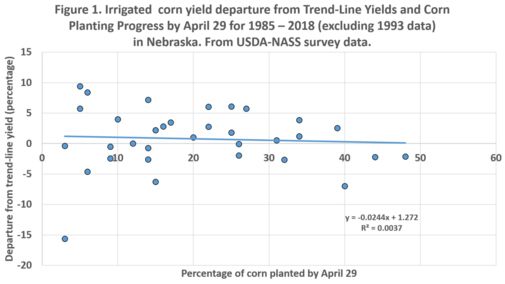Does the “early bird” always get the worm? We wonder if this old adage holds for corn planting dates too. Does planting early always result in maximum corn yields? We know―and often say―that on average early planting results in higher yields. We use rules of thumb and often cite specific numbers of yield loss per day delay in May. The answer to the question above, at least with corn, is: No, early planting does not always result in maximum yields.
Also see what research across the Corn Belt indicates on an optimum corn planting window.We’ll address this question by looking at Nebraska data from the Ph.D. research of Angela Bastidas and from the USDA National Agricultural Statistics Service. In another CropWatch article, we’ll look at related research from across the Corn Belt.
Nebraska Data from UNL
The objective of Bastidas’s work was to investigate yields of different comparative relative maturity (CRM) hybrids for use in cropping systems that incorporate cover crops (see this CropWatch article for the research background). Several CRM hybrids were planted during mid-May and early-June for two years at the university’s South Central Agricultural Lab near Clay Center (Table 1).
The responses of hybrids to planting date are especially obvious with the late-CRM hybrids planted in mid-May in comparison to those planted in early-June (253 versus 226 bushels per acre). In her studies, fuller-season hybrids responded better to the earlier planting date relative to the later planting dates; the early to medium CRM hybrids were not affected by later planting. We’ve got to remember that the “early planting date” of mid-May was not early for the Clay Center area.
| Planting date x CRM | Yield bu/acre |
Mean | Relative yield (%) |
|---|---|---|---|
| Mid-May x Early2 | 192 | d | 76 |
| Mid-May x Early to Medium | 235 | bc | 93 |
| Mid-May x Medium | 248 | ab | 98 |
| Mid-May x Late | 253 | ab | 100 |
| Early-June x Early | 197 | d | 78 |
| Early-June x Early to Medium | 239 | bc | 94 |
| Early-June x Medium | 245 | ab | 97 |
| Early-June x Late | 226 | c | 89 |
| 1 Yields with different letters in the adjacent column indicate statistical differences at the 0.05 probability level. 2 Early CRM = 80-86 days; early to medium = 92-95 days; medium = 97-105 days; late = 111-115 days |
|||
USDA-NASS Nebraska Data
Another method to help answer this question in Nebraska is to compare weekly planting progress from USDA-NASS Nebraska data over the last several years to trend-line yields in the same years (following the same procedures of our colleague Bob Nielsen at Purdue University in Indiana). This should show us whether years in which we’re able to plant the crop earlier actually have higher absolute yields at harvest. In other words, does planting earlier correlate with higher yields.
Figure Layout
First, let’s review how the figures are laid out. Figures 1-4 show the results of this comparison with Nebraska data from 1985 to 2018. Departures from trend-line yield are shown, based on the amount of Nebraska’s corn that had been planted on either the week ending April 29 (Figures 1 and 3) or the week ending May 13 (Figures 2 and 4). Since there are large differences in trend-line yields between our rainfed and irrigated production areas, we separated data from these two production environments: irrigated, Figures 1 and 2, and rainfed, Figures 3 and 4.
The USDA-NASS weekly reports do not separate the percent of the crop planted into irrigated and rainfed categories so we used the same corn planting progress for both irrigated and rainfed graphs (Figures 1-4). That assumes that irrigated and rainfed farmers plant corn on roughly the same schedule. Data from 1993 were not included in the trend lines for the irrigated data (Figures 1-2) because of the impact of widespread greensnap on yields in that year. Also, 2012 data were dropped from the rainfed figures (Figures 3-4) because of the drought in that year.
On these figures, the X-axis – the horizontal axis – represents the percentage of corn planted statewide ending that week of the year over the 33 years. The Y-axis – the vertical axis – represents the difference between the actual statewide yield recorded that year and the trend-line yield for that same year. With that in mind, every marker on the charts represents the yield in a specific year relative to the trend-line yield. For example, on Figure 1, the marker in the lower left corner indicates that in that specific year, which happens to be 1995, irrigated corn yields were more than 15% below the trend-line yields (1995 trend-line yield = 154; 1995 actual yield = 130 bushels per acre), and on the week ending April 29, 1995, only 3% of the crop was planted. By the way, that’s 1995 data in the lower left corner of Figures 2-4 also. Spring rains in 1995 delayed planting, according to the USDA-NASS. Only 11% of Nebraska’s corn was planted by May 14, 1995, compared to the five-year average of 72%. Delayed planting resulted in late silking; by the end of July, only 31% of Nebraska’s corn was silked compared to 77% for the five-year average.
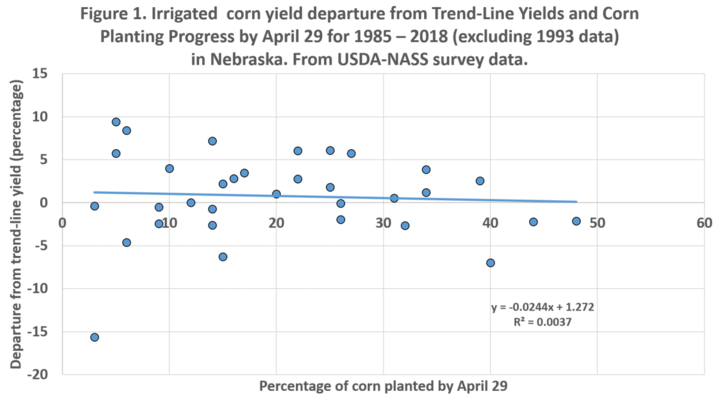
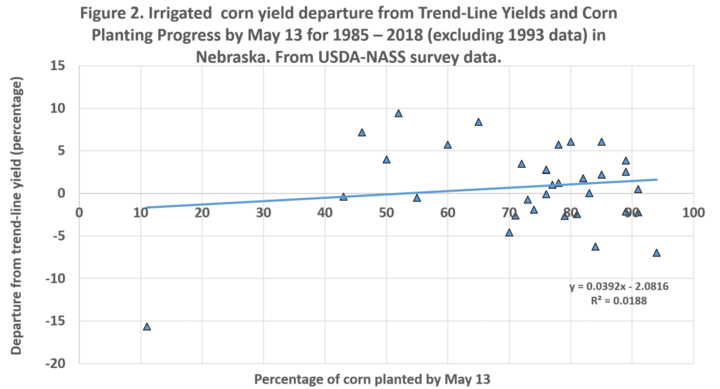
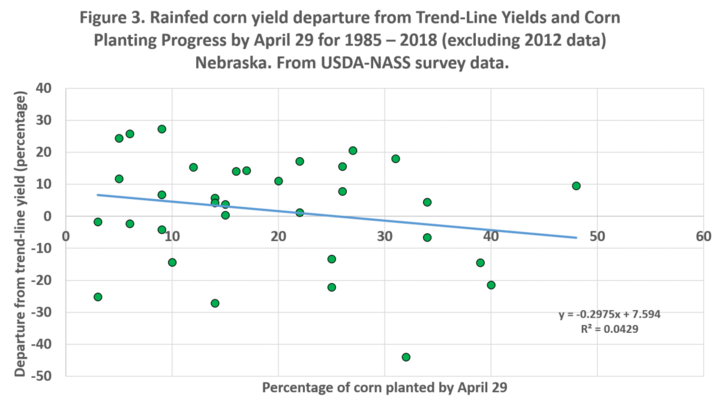
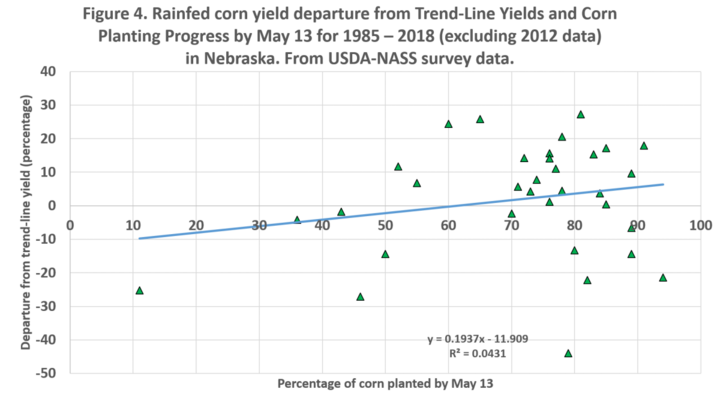
Interpreting the Figure Data
Nebraska’s irrigated yields, based on the USDA-NASS data, increased at a rate of 2.26 bushels per acre per year between 1985 and 2018. That number was used to develop yield trends. Figures 1-2 display the relative yields of irrigated corn based on planting progress in those years. The percent of Nebraska irrigated corn planted by April 29 does not appear related to the final yields over the years (Figure 1). The same is true when planting progress is compared to yields two weeks later, the week ending May 13 (Figure 2); there is no indication that final irrigated yields are related to the amount of corn planted by that date in mid-May.
Nebraska rainfed yields have increased by 2.1 bushels per acre per year since 1985. As you look at Figures 3-4, you can conclude the same thing we saw in the irrigated figures: There is no relationship between planting before mid-May and corn yields, based on this information.
Considerations Relative to Planting Corn
- A planting window exists within which yields do not vary tremendously. That window starts to close after mid-May. (See Cold Soil Temperature and Corn Planting Windows.)
- Many factors in addition to planting date influence final yields.
- There is always a chance that late-planted corn may out-yield early-planted corn. Nielsen discusses that and displays the concept in Figure 3 of his article.
- “Mudding in” any crop is taking a large risk. Yield potential is likely lost immediately if emergence rates and timing are compromised. This may nullify any potential advantage for early planting. In fact, poor stands may require replanting (see related CropWatch article) and result in even lower yield potential and economic returns.
- Soil temperatures are usually conducive for planting corn by late April. Nevertheless, keep an eye on them. Planting into cold soils prior to a certain, drastic, dip in temperatures may not result in good stands. (See in CW, Cold Soil Temperature and Corn Planting Windows.) Poorer stands and uneven emergence will reduce yields.
Conclusion
The answer to the question posed in the first paragraph is, of course, "No." Early planting does not always maximize yields. Watch soil conditions and weather forecasts.
We are not avid bird watchers, but, it seems like the observant, persistent, and patient ones are the ones that fly back to their nests with squirming “goodies” for their eagerly chirping and rapidly growing young ones. Being patient pays for birds and for those of us planting corn.
References
Bastidas, Angela. 2017. Cover Crop Introduction into Corn (Zea mays L.)-Soybean (Glycine max L.) Cropping Systems. Ph.D. Dissertation. The University of Nebraska. (Click here for a download)
Bastidas, Angela, Chris Proctor, and Roger Elmore. 2016. Finding the balance between corn yield and cover crop biomass. The University of Nebraska Extension. CropWatch. Nov. 29, 2016.
Elmore, Roger, Jim Specht, Jenny Rees, Haishun Yang, and Patricio Grassini. 2018. Cold soil temperature and corn planting windows. The University of Nebraska Extension. CropWatch. April 12, 2018.
Nielsen, R.L. 2019. The planting date conundrum for corn. Purdue University Agronomy.
USDA-NASS. 1995. Nebraska Weather and Crops. Issues 09-95, May 15, 1995, and 20-95, July 31, 1995.
USDA-NASS. 2019. Quick Stats.
